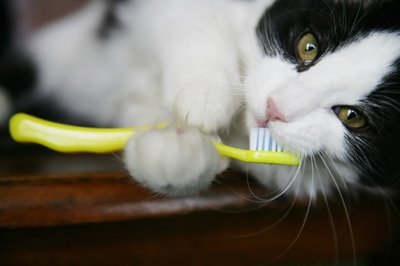Home Dental Care For Your Pet
In order for any dental program to work properly, home care follow-up is essential. Brushing your pet’s teeth is the single most important procedure you can do to maintain good oral health. If performed regularly, daily brushing will dramatically increase the interval between teeth cleaning appointments.
Plaque is constantly being made and deposited in the mouth. Humans have a buildup of plaque in the morning. This accumulation of plaque makes our breath smell bad. Proper dental care, for dogs as well as humans, can keep plaque buildup under control. People brush their teeth several times daily to remove plaque — why not our pets? The goal of dental home care is to remove plaque from tooth surfaces and under the gum line before it mineralizes into calculus, a process that occurs within days of a teeth cleaning. Success depends on the owner’s ability to brush the pet’s teeth, as well as the dog or cat’s acceptance of the process. True oral cleanliness can only be achieved through the mechanical action of toothbrush bristles above and below the gum line.
Home care is best started at a young age, before the adult teeth erupt. The younger the animal is, the more likely he or she is to accept it. Your veterinarian may discuss the advantages of home dental care at the time of your pet’s first vaccinations. Daily brushing not only keeps your pet’s teeth clean and healthy, it also enhances the bond between you and your pet.

A misconception is that hard food keeps pets’ teeth clean. Some believe that when their dog or cat chews on hard food or biscuits, mineral deposits are broken down and the teeth stay clean. This is not true. Granted, animals on soft diets accumulate plaque more readily than those on dry foods, but the only way to keep teeth clean above and below the gum line is by daily brushing.
If you are unsure of how to brush your pet’s teeth, you may want to ask a veterinary hospital staff member for instructions or watch this video by the American Veterinary Medical Association. Proper brushing technique involves applying the bristles at a 45-degree angle to the gums. Use small circular motions around the outside of the teeth, being sure to get the bristles under the gum line. It is not as important to brush the inside of the teeth, as dogs and cats do not accumulate as much tartar on the insides of their teeth.
The most important area to keep plaque and tartar from accumulating is under the gum line. Adding products such as Oxyfresh to the drinking water or rubbing the teeth with dentifrice impregnated pads may help in home care, but it’s necessary to understand that periodontal disease begins below the free margin of the gum line.
Getting Your Pet to Accept Tooth Brushing
• Start with a healthy comfortable mouth – Untreated problems can cause pain and a non-compliant patient. Dental pathology must be cared for first. If you suspect that your pet has an accumulation of tartar, a painful mouth (he pulls away each time you touch his head or jaw), bad breath, or a problem chewing, drinking or swallowing, a veterinary dental exam is in order.
• Choose a proper toothbrush and toothpaste – Toothbrushes have bristles that reach under the gum line and clean the space that surrounds each tooth. Plaque accumulates in this space. Devices such as gauze pads, sponge swabs, or cotton swabs remove plaque above the gum line, but cannot adequately clean the space below the gum line.
• The size of the toothbrush you choose is important – There are specific brushes for mouths of long muzzled dogs, as well as small brushes for cats. Each dog or cat must have his or her own toothbrush. Sharing brushes may result in cross contamination of bacteria from one pet to another.
• Introduce the toothpaste and toothbrush gradually – When you sense that your pet has had enough, give him reassurance by talking and try again. Expect progress not perfection. Reward progress immediately with a treat or a play period after each cleaning session. Don’t expect to brush your pet’s teeth on the first try. Take time. Each pet is different. Some will be trained in one week, while others will take a month or more. The payoff is well worth the learning curve.
The type of dental home care products dispensed by your veterinarian may vary from animal to animal. Trust your veterinarian to dispense the products that are best suited to your own pet’s dental needs.